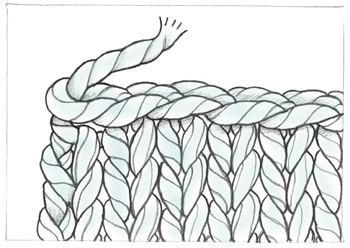This column by Barbara Breiter, author of The Complete Idiot’s Guide to Knitting & Crocheting, originally appeared in The Weekly Stitch newsletter.

Ahhh, finally done with your latest knitting project. Now you can’t wait to finish so, in a final flurry, you bind off all your stitches and…oh no. The sweater won’t fit over your head or the bound off edge of the blanket is narrower than the cast on edge.
What have you done? You bound off too tightly.
I’ve done it myself. You might not notice if it’s a scarf because a scarf is narrow. The bound off edge does not have as much “give” as the rest of the knitting. That’s why it’s difficult to get the neckline of that sweater to stretch enough to fit over your head.
Always, always, always bind off loosely. This includes the stitches that you are knitting or purling during the process as well as when you pass a stitch over and off. Don’t tug, pull, or yank the yarn as you work each stitch. I know that it seems so loose that it’s tempting. But don’t. If you find you are binding off too tightly and can’t manage to do it more loosely, use needles one or two sizes larger than the size you used to knit the piece.
Binding off, sometimes called casting off, actually creates a final row of fabric, so what stitches you work as you bind off does make a difference. You can simply knit across as you bind off as many people do; but upon close inspection you’ll see the difference in the details.
If the next row calls for you to knit but instead it’s time for you to bind off, you’ll bind off in knit. Just knit each stitch as you bind off across. If the next row calls for you to purl but instead it’s time for you to bind off, you’ll bind off in purl and purl each stitch.
When working a stitch pattern that involves multiples knits and purls on a row, your pattern instructions may state, “Bind off in pattern.” Even if it doesn’t say to do this, it’s a good practice and will add an extra detail.
This means you should bind off using whatever stitch you would use to continue the established pattern. Pretend you are going to continue to work the next row; if you were knitting a stitch pattern with an 8 row repeat and your piece ended with Row 8, you would use Row 1 as a guide while binding off. Knit or purl each stitch before it’s bound off as per the pattern. If the next stitch would have been a purl, purl that stitch and bind off. If the next stitch would have been a knit, knit that stitch and bind off.
You’ll find many situations in which you bind off only part of the stitches across a row, such as shaping the armhole or the neck of a sweater. For example, the instructions might tell you to bind off 5 stitches at the beginning of the next two rows. To continue working across the row and have your yarn in the appropriate place, you can only bind off stitches at the beginning of a row.
To bind off 5 stitches, you’re actually knitting 6 stitches; the last stitch will remain on the right needle and end up as the first stitch of the row. Remember, after you’ve lifted the first stitch up and over the second stitch on the right needle, this counts as 1 bound off stitch.
As with casting on, there are lots of different ways to bind off to make different functional and decorative edges. If you’re interested in learning more about binding off, pick up one of the books available that showcase dozens of different techniques. Several have come out in just the last year.
–-
To sign up for the Weekly Stitch and get columns like this, free patterns, how-to videos and more, click here.
3 Ways to Bind Off/Cast Off | Yarn Buyer
[…] http://blog.lionbrand.com/2014/07/28/3-ways-to-bind-offcast-off/ […]
susanswerphone
Sometimes going up a needle size just to bind off does the trick, i tend to be a tight knitter, so it works for me.
Petrina
Great tip. Thanks for sharing!
Helen Griffin
There are several ways to bind off, too. PRE planning, you can select a matching cast on and bind off.. (there are about a dozen choices! ) Even with out pre-planning some bind offs are naturally stretchier.